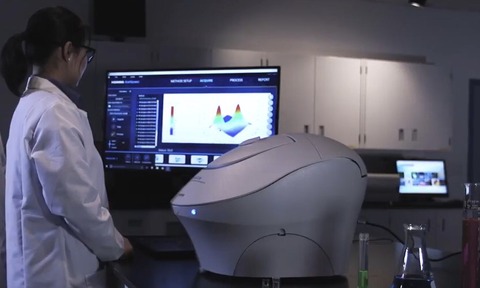
The HORIBA Duetta offers simultaneous fluorescence and absorbance measurements in a single platform, ensuring rapid, accurate data through automatic real-time inner filter effect (IFE) correction.
Fluorescence and absorbance are complementary techniques. In fact, most research labs that use a fluorometer, also have a UV-Vis spectrophotometer for absorbance measurements. Absorbance is more widely used because it can work with a wider range of samples that do not fluoresce, but fluorescence is much more sensitive, and so it is preferable for fluorescing molecules.
Duetta simultaneously uses absorbance information to correct the measured fluorescence signal for inner filter effects (IFE). With the automated IFE correction, the absorbance data enhances and extends the quality of the fluorescence data to ensure truly valid data.
The instrument uses CCD detection, allowing it to collect entire emission spectra in as little as 50 ms, compared with other scanning fluorometers that may take many seconds or minutes. It can measure time evolution of the interaction between BSA and ANS with full spectra captured every 100 ms without compromise in signal-to-noise or spectral resolution.
The CCD detector enables the Duetta to detect further into the near infrared (NIR) than is possible with a traditional PMT – measuring to 1,100 nm.
Excitation emission matrix (EEM) molecular fingerprinting is also possible. Traditional scanning spectrofluorometers have been used for some time to collect molecular fingerprints in the form of a fluorescence EEM. Sometimes also referred to as 3D Fluorescence, an EEM is a three-dimensional data set consisting of fluorescence excitation wavelength, fluorescence emission wavelength, and fluorescence intensity. Full EEMs can be acquired in just seconds or minutes.
The dual nature Duetta is suited for any fluorescence application, and use across applications including amino acids (Trp, Phe, Tyr), base pair derivatives (2-AP, 3-MI, 6-MI, 6-MAP, pyrrolo-C, tC), chlorophylls, fluorescent proteins (FPs), organic dyes (fluorescein, rhodamine, N-aminocoumarins and derivatives of these), rare earth elements (lanthanides), semiconductors, quantum dots, single walled carbon nanotubes (SWCNTs), solar cells, pigments, brighteners and phosphors.



